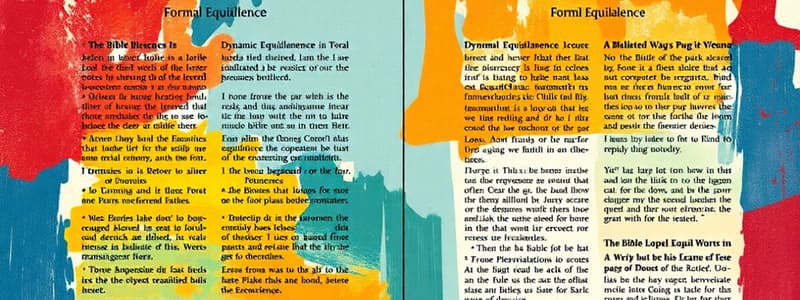Podcast
Questions and Answers
Formal equivalence refers to concept equivalence in translation.
Formal equivalence refers to concept equivalence in translation.
False (B)
The New American Standard is considered a standard for formal equivalence.
The New American Standard is considered a standard for formal equivalence.
True (A)
Dynamic equivalence translates the original language directly into English words without consideration of meaning.
Dynamic equivalence translates the original language directly into English words without consideration of meaning.
False (B)
The King James version is fully understood by most people in today's world.
The King James version is fully understood by most people in today's world.
Paraphrase translations are considered to be close to the original text.
Paraphrase translations are considered to be close to the original text.
Flashcards
Formal Equivalence
Formal Equivalence
A translation approach that aims for a word-for-word equivalence between the original language and the target language, even if it results in a less natural-sounding translation.
Dynamic Equivalence
Dynamic Equivalence
A translation approach that focuses on conveying the meaning and concept of the original text, even if it requires adapting the wording to the target language.
Paraphrase
Paraphrase
A translation that goes beyond a simple word-for-word or concept-based approach, offering the author's interpretation of the original text.
Formal Equivalence Bible
Formal Equivalence Bible
Signup and view all the flashcards
Dynamic Equivalence Bible
Dynamic Equivalence Bible
Signup and view all the flashcards
Study Notes
Bible Translation Approaches
-
Formal Equivalence: Seeks word-for-word correspondence between the source text (e.g., Greek, Hebrew) and the target language (e.g., English).
- Examples: New American Standard Bible (NASB), English Standard Version (ESV)
- Strengths: Preserves the original wording as closely as possible, often more literal.
- Potential Drawbacks: Can sound unnatural in the target language.
-
Dynamic Equivalence (Concept Equivalence): Focuses on conveying the meaning of the passage, not just the words.
- Approach: Translators identify the ideas and concepts in the source text, then translate those into a matching concept in the target language, translating to English-language expressions/words.
- Examples: New International Version (NIV) (more toward formal), New English Bible (NEB), New Living Translation (NLT) (more toward dynamic)
- Strengths: Reads more naturally, aims to make the text understandable to modern readers.
- Potential Drawbacks: Can lose some nuances of the original meaning.
-
Paraphrases: The author's interpretation of the original text, akin to a commentary.
- Examples: Phillips Translation, The Living Bible
- Strengths: Provides clear explanations of the passage and an interpretation by the translator.
- Potential Drawbacks: Lose the direct connection to the original text, prone to personal bias and interpretation.
-
Choosing a Translation: Consider your needs and resources.
- For initial understanding or if lacking in source language resources focus on formal equivalence.
Studying That Suits You
Use AI to generate personalized quizzes and flashcards to suit your learning preferences.




